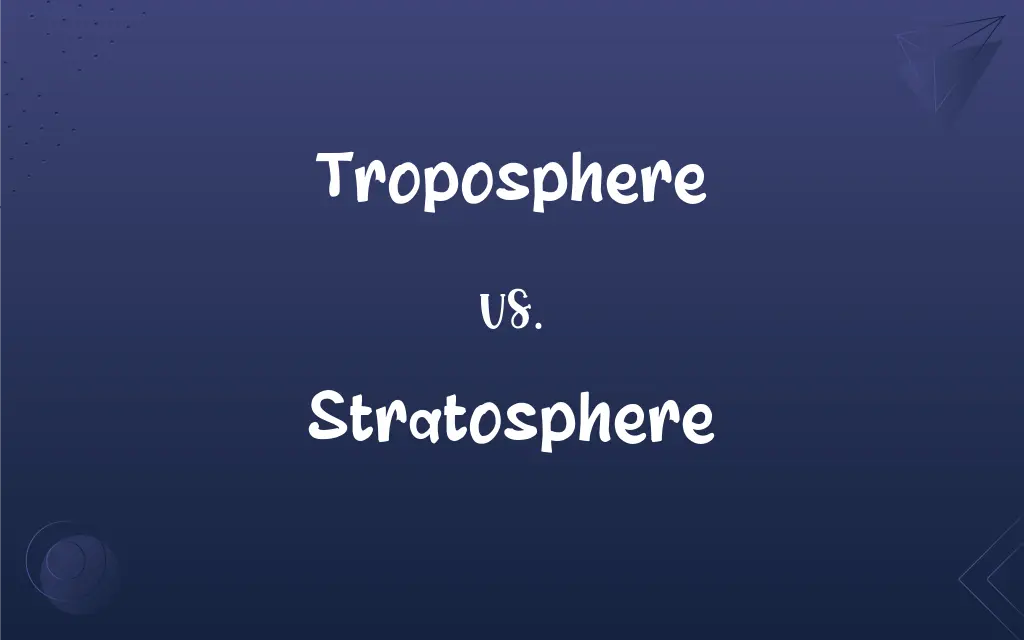Troposphere vs. Stratosphere: What's the Difference?
Edited by Aimie Carlson || By Janet White || Published on February 6, 2024
The troposphere is the Earth's lowest atmospheric layer with weather phenomena; the stratosphere lies above it, containing the ozone layer and experiencing temperature inversion.

Key Differences
The troposphere is the closest atmospheric layer to the Earth's surface, extending up to about 6-20 km. It is characterized by decreasing temperature with altitude and is the layer where all weather phenomena occur. The stratosphere, on the other hand, lies directly above the troposphere, extending from about 20 km to 50 km altitude. Unlike the troposphere, the stratosphere experiences an increase in temperature with altitude, mainly due to the absorption of ultraviolet radiation by the ozone layer.
The troposphere contains about 75% of the Earth's atmosphere's mass and is where the majority of atmospheric water vapor is found. This concentration of water vapor contributes to the troposphere's dynamic weather patterns. The stratosphere, in contrast, is drier and contains little water vapor. It is relatively stable with few weather disturbances, known mainly for its ozone layer, which absorbs and scatters the Sun's harmful ultraviolet rays.
The boundary between the troposphere and the stratosphere is called the tropopause, where the temperature stops decreasing with altitude. In the troposphere, the temperature generally decreases with altitude at a rate of about 6.5°C per kilometer. However, in the stratosphere, the temperature trend reverses, and the air gets warmer with increasing altitude, primarily due to ozone absorption of solar radiation.
The troposphere's dynamics are heavily influenced by the Earth's surface, including landforms and oceans, making it highly variable in terms of temperature and weather patterns. The stratosphere is less influenced by surface conditions and is characterized by more stable conditions, with jet streams and stratified layers of air.
Weather phenomena such as clouds, rain, snow, and storms are confined to the troposphere. The stratosphere, being free of such weather activities, is known for its clear and stable conditions, which is why long-distance flights often cruise in the lower stratosphere to avoid turbulence and bad weather typically found in the troposphere.
ADVERTISEMENT
Comparison Chart
Location
Closest to Earth, up to 6-20 km
Above troposphere, 20-50 km
Temperature Gradient
Decreases with altitude
Increases with altitude
Composition
Contains most of the atmospheric mass and water vapor
Drier, contains the ozone layer
Weather
All weather phenomena occur
Stable, little to no weather
Influence
Heavily influenced by Earth's surface
Less influenced by surface, more stable
ADVERTISEMENT
Troposphere and Stratosphere Definitions
Troposphere
The troposphere is where weather changes and phenomena occur.
Meteorologists study the troposphere to understand rain patterns.
Stratosphere
The stratosphere is the second layer of Earth's atmosphere above the troposphere.
The stratosphere is known for its calm conditions, ideal for aviation.
Troposphere
The troposphere extends up to the tropopause, its upper boundary.
The tropopause marks the transition from the troposphere to the stratosphere.
Stratosphere
The stratosphere contains the ozone layer, which absorbs ultraviolet light.
The ozone layer in the stratosphere protects life on Earth from harmful UV rays.
Troposphere
The troposphere contains most of Earth's atmospheric water vapor.
The formation of clouds primarily occurs in the troposphere.
Stratosphere
In the stratosphere, the temperature increases with altitude.
Unlike the troposphere, the stratosphere gets warmer the higher you go.
Troposphere
The troposphere is the lowest layer of Earth's atmosphere.
Weather balloons collect data from the troposphere to forecast weather.
Stratosphere
The stratosphere is characterized by stable air conditions and a lack of weather.
The stratosphere's stability is due to its limited interaction with the Earth's surface.
Troposphere
The temperature in the troposphere decreases with altitude.
Climbing a mountain in the troposphere, the air gets colder.
Stratosphere
The stratosphere extends from about 20 km to 50 km above the Earth's surface.
Weather balloons can ascend into the lower regions of the stratosphere.
Troposphere
The lowest region of the atmosphere between the earth's surface and the tropopause, characterized by decreasing temperature with increasing altitude.
Stratosphere
The region of the atmosphere above the troposphere and below the mesosphere.
Troposphere
The lower levels of the atmosphere extending from the surface of the Earth or another celestial body up to the tropopause. It is characterized by convective air movements and a large vertical temperature change.
Stratosphere
An extremely high or the highest point or degree on a ranked scale
Business expenses in the stratosphere.
Troposphere
The lowest atmospheric layer; from 4 to 11 miles high (depending on latitude)
Stratosphere
Collectively, those layers of the Earth’s crust which primarily comprise stratified deposits.
Stratosphere
(meteorology) The region of the uppermost atmosphere where temperature increases along with the altitude due to the absorption of solar ultraviolet radiation by ozone. The stratosphere extends from the tropopause (10–15 kilometers) to approximately 50 kilometers, where it is succeeded by the mesosphere.
Stratosphere
The atmospheric layer between the troposphere and the mesosphere
FAQs
What is the altitude range of the stratosphere?
The stratosphere extends from about 20 km to 50 km above the Earth's surface.
Does the troposphere contain the ozone layer?
No, the ozone layer is primarily located in the stratosphere.
What is the stratosphere known for?
The stratosphere is known for the ozone layer and increasing temperature with altitude.
What defines the troposphere?
The troposphere is the lowest atmospheric layer, marked by decreasing temperature with altitude and weather phenomena.
How high does the troposphere extend?
The troposphere extends from the Earth's surface up to about 6-20 km.
What is the temperature trend in the troposphere?
Temperature generally decreases with altitude in the troposphere.
What is the boundary between the troposphere and stratosphere called?
The boundary is known as the tropopause.
Can the ozone layer in the stratosphere affect weather?
The ozone layer primarily affects UV radiation absorption, not weather.
How does the water vapor content compare between the troposphere and stratosphere?
The troposphere contains most of the atmospheric water vapor, while the stratosphere is much drier.
How does temperature change in the stratosphere?
In the stratosphere, temperature increases with altitude.
Why is the stratosphere important for Earth's environment?
The stratosphere's ozone layer is crucial for protecting life on Earth from harmful ultraviolet radiation.
Is weather a feature of the stratosphere?
No, the stratosphere is characterized by a lack of weather phenomena.
Are commercial flights conducted in the troposphere?
Commercial flights usually cruise in the lower stratosphere to avoid tropospheric weather.
Is the troposphere affected by human activities?
Yes, the troposphere is significantly affected by human activities like pollution.
Do meteorological phenomena occur in the stratosphere?
Meteorological phenomena are almost exclusively confined to the troposphere.
Why is the stratosphere stable compared to the troposphere?
The stratosphere is stable due to its stratified layers and minimal surface interaction.
Does the troposphere impact Earth's climate?
Yes, the troposphere plays a crucial role in Earth's climate and weather systems.
What causes the temperature inversion in the stratosphere?
Temperature inversion in the stratosphere is caused by UV radiation absorption by the ozone layer.
Do aircraft need special considerations when flying in the stratosphere?
Aircraft require pressurization and temperature control to operate in the stratosphere.
Are there clouds in the stratosphere?
Clouds are rare in the stratosphere due to the low water vapor content.
About Author
Written by
Janet WhiteJanet White has been an esteemed writer and blogger for Difference Wiki. Holding a Master's degree in Science and Medical Journalism from the prestigious Boston University, she has consistently demonstrated her expertise and passion for her field. When she's not immersed in her work, Janet relishes her time exercising, delving into a good book, and cherishing moments with friends and family.
Edited by
Aimie CarlsonAimie Carlson, holding a master's degree in English literature, is a fervent English language enthusiast. She lends her writing talents to Difference Wiki, a prominent website that specializes in comparisons, offering readers insightful analyses that both captivate and inform.







































































